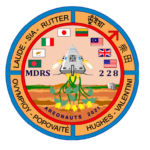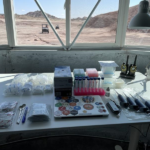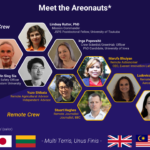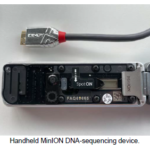THE AREONAUTS: CREW 228
Crew 228, also known as the Areonauts, is an international crew selected by the Mars Society. Our team traveled to the Mars Desert Research Station this year to help put humans on Mars. We are engineers, artists, sociologists, astronomers, biologists, journalists, and physicians, who hail from all walks of life and eight nations. But most of all, we are explorers. The word ‘Areonaut’ is derived from the Greek roots Ares (Mars) and nautes (sailor), translating to ‘sailor of Mars’. Our motto, Multi Terris, Unus Finis (many nations, one goal) reflects our internationality.
Although we started as a group of strangers who had never met before in person, we shared the common goal to serve as “one small step” toward sending humankind to Mars. Over 2.5 years, we carefully prepared for a productive mission on the Red Planet from all across the globe.
From September 26 to October 9, 2021 we conducted various activities in simulated space conditions. To read more about the symbology of our mission patch and details about our research and outreach activities, please view our mission website at:
RESEARCH PROJECTS
Sociological study of group processes in a space analog environment
By: Inga Popovaite
For two weeks, Inga Popovaite collected data for her doctoral dissertation (University of Iowa IRB#201911141). She leaves MDRS with ~24 pages of notes (17k words) that document every day on “Mars”. In her dissertation Inga examines crew interactions from the structural, as opposed to the individual, perspective. Her work will contribute to the growing body of literature that examines group processes in isolated, confined, and extreme environments.
Sparks of creativity in isolated and confined environment helps with group cohesion
In addition to participant observation, Inga tested data collection instruments for a future research project in which she wants to investigate emotion management in isolated, confined, and extreme environments. Crew 228 were given individual journals and were asked to write daily entries based on provided prompts. Based on their suggestions, Inga plans to use digital journaling in the future instead of a pen-and-paper version. She is also rethinking how this project can be better incorporated into MDRS crews’ daily routines.
Lastly, during her time here, Inga found some time to work on a presentation for the Mars Society International Convention, which is happening in a week. In her talk she will be talking about how unsupervised machine learning algorithms (sentiment analysis and structural topic modeling) can be used to infer behavioral patterns from crews’ daily reports.
MDRS GIS map update
By: Jin Sia
In collaboration with: Marc Levesque
Jin suggested information to be added to the MDRS GIS map that corresponded to useful or interesting geographic features. Furthermore, he provided feedback on the formatting of the draft EVA planning map provided by Marc, such as about the usefulness of including an optical map as well as a topographical one, and providing coordinates in DD (Decimal Degrees) as well as UTM (Universal Transverse Mercator.)
GIS mapping of MDRS area
By: Jin Sia
In collaboration with: Marc Levesque
Jin explored the applications of GIS (Geographic Information Systems) for EVA planning and real-time EVA support at the MDRS. Initially, he created a digital map of the area in ArcGIS Pro using data provided by Marc Levesque (Commander, Crew 216) with the intent of starting a process of accumulating scientific SOIs (Sites Of Interest) that would be passed down from crew to crew.
However, he soon concluded that this specific system would likely be impractical due to the limited availability of the software, standardization issues, and other logistical complexities. Instead, he learned several valuable lessons and found unexpectedly useful insights from using the software.
Firstly, as planned, he supported Lindsay’s field microbe genomics project by recording geographic data for samples she collected using the GPS Essentials app. With the help of a visualization of the sample collection sites in ArcGIS Pro with aerial imagery and a DEM (Digital Elevation Model), Lindsay concluded that she had taken samples from a sufficiently diverse range of sites.
Secondly, an unexpected finding was the usefulness of ArcGIS Pro for real-time EVA support. When the EVA team ran into issues locating the target site, they provided Jin with a GPS fix, and he was able to provide them with a bearing and distance to it using the existing digital map in ArcGIS Pro.
Thirdly, Jin noticed during the mission that he could calculate the slope at each point in the map based on the DEM. Using the resulting map, he helped Dave and Inga locate a pass with a gentle average slope that would provide them with access to the dried-up river delta southwest of the Kissing Camel Ridges, which is underexplored. Using the 3D Map feature in ArcGIS Pro also helped them visualize the expected topography on arrival at the site.
Finally, Jin also noticed during the mission that he could perform a viewshed calculation based on the DEM, which was useful for determining whether a radio would have direct line-of-sight to the Hab in every point on the map. He and Inga performed an EVA to verify the accuracy of this calculation. He learned that while the calculation was pessimistic in predicting whether radio reception would be available, it was still useful for finding areas with poor reception or radio blackout. Based on these findings, he recommended that EVA protocol require teams to check in with HabComm and provide an estimated time to reestablishment of radio contact before entering blackout zones.
Future MDRS Research Project Conceptual Investigation
By: David Laude
Dave investigated the prospects of a research project for his next rotation should he be so fortunate. It made good use of a few crew hours at MDRS. What would a nascent Martian colony want or need to be different on Mars from the culture and civilizations on Earth for the better? Why not ask the crew members in a Mars sim? An hour session was conducted mid-sim with all crew participation. Discussions resulted in the idea that just discovering relevant attributes to consider would be beneficial, even if no further details on the subject were immediately forthcoming. Some technological/societal/cultural subjects revealed were food production, labor shortages, extended families living together and reliance upon each other. Full discussions on a single subject could take considerable time and so would have to be limited when considering crew participation. More thought will be required to identify an efficient use of crew time for this potential research project. Most of the work to develop this for publication would have to be completed on Earth.
In-situ, real-time metagenomics analysis of MDRS regolith using the Oxford MinION
By: Lindsay Rutter
In this project, Lindsay added to a unique body of astrobiological research that has been conducted by scientists at MDRS. She will continue to add the next logical “stepping stone” in this stream of work that started 16 years ago. Below is a timeline of the previous work and how her project builds to it.
2005: Moran et al. confirmed the presence of methane in the Utah desert soil around MDRS [1]. The authors provided preliminary evidence (using growth medium) that the methane could be derived by microbes, a finding that, if verified, would be intriguing given that methanogens were not known to survive in desert regolith. Interestingly, around this same time, methane was detected on Mars, where it remains unknown if it is biological in origin.
2011: Direito et al. [2] and Thiel et al. [3] conducted 16S rRNA studies and PCR-based detection surveys at MDRS. Both groups confirmed high bacterial diversity in the Utah desert soil.
2020: Maggiori et al. [4] performed the first metagenomics study of Utah desert soil around MDRS using the handheld nanopore sequencing technology of the Oxford Nanopore MinION [5]. Metagenomics (the study of genetic material collected directly from environmental samples) is a new approach that allows biologists to examine all members in a microbial community at once (regardless of whether they can be cultured). Maggiori et al. characterized a rich microbial community that included several methanogens, which verified the unexpected preliminary evidence from 2005 that methanogens can indeed survive in desert conditions. Maggiori et al. [4] performed their MinION sequencing on MDRS samples returned to their home lab.
During this mission, Lindsay attempted to replicate Maggiori et al.’s findings – but, this time, to perform the MinION sequencing directly at MDRS, instead of her home lab. Because she did not have access to expensive sequencing facilities, she used a “field sequencing kit”, a kit even more designed for remote environments than what Maggiori et al. used. Her study could serve as a proof-of-concept that sequencing can be done in remote space analog environments far away from sequencing facilities, all while under planetary exploration operations.
All equipment used for this study.
Lindsay attempted to replicate Maggiori et al.’s findings by returning to the exact same desert feature from which the previous authors collected their samples – an inverted river channel called Jotunheim, located about 1 kilometer North of the habitat. Before the mission ended, Lindsay was able to obtain a small amount of DNA reads (about 1,000 per sample). Upon returning to her home lab, she will determine the quality and characteristics of these reads and whether similar microorganisms were detected.
Handheld MinION DNA-sequencing device.
Back at her home lab, Lindsay will analyze the samples again not just for the microbial diversity (metagenomics), but also the microbial ecology (metatranscriptomics), of the Utah desert soil around MDRS. This would allow us to increase the resolution and understand not just what microorganisms are present, but also what biochemical pathways and substrates they use to survive. Overall, the project will use MinION to sequence DNA and RNA to identify methane-producing metabolic pathways of the methanogens that were recently
detected for the first time in the desert environment.
OUTREACH PROJECTS
Areonauts sharing their mission with elementary, middle, and high school students
By: everyone
This project is led by Stuart Hughes and Lindsay Rutter, with participation from all other crew members. Lindsay Rutter gave virtual presentations about our mission to elementary students (4th and 5th grade), middle school students (7th grade), and high school students (11th grade) through the program “Skype a Scientist”. All together, the presentation about our mission was seen by about 250 students, many of whom sent in questions afterward.
The questions from the students spanned various fields from space farming to life support system engineering to planetary science to space medicine. We filmed short videos to answer the elementary students’ questions, and wrote answers to the older students. Stuart Hughes will help with video editing. The crew will send the final video to all classrooms that participated.
Areonauts at the Space Week 2021
By: Ludovica Valentini
Supported by the whole crew
Ludovica presented the crew 228 and their “hybrid” simulation during the Space Week 2021 in the Italian region Marche. In-situ crew shared their videos and photos, and remote crew helped editing the footage and sharing their remote experience.
Media outreach
By: Inga Popovaite
Inga got >33 GB pictures and videos which she will use to tell a story about her research, MDRS, and Mars analogs more generally to various Lithuanian media outlets and the University of Iowa alumni magazine.
Diaries from Analog Mars
By: Jin Sia
On behalf of: Mars Society of Canada
Jin wrote daily diary entries for the Mars Society of Canada’s Marslog (marssociety.ca/marslog.) He provided a candid, storied perspective into space analog life that was well-received by the public.
Mars-to-Mars (M2M) Video Link
By: Lindsay Rutter, Inga Popovaite, Jin Sia, and David Laude
The AARG-1 (American Public University System Analog Research Group) crew at the University of North Dakota’s ILMAH (Inflatable Lunar/Mars Analog Habitat) analog site, by happy coincidence, were also conducting a simulated Mars mission at the same time as the Areonauts. On October 8 (Sol 11), they joined a cross-planetary video conference together called M2M (Mars-to-Mars) Video Link that was broadcasted live to Earth, during which they discussed space analogs and World Space Week.
RECREATIONAL PROJECTS
Lunch Time TV
We watched two episodes of the science fiction TV series Moonbase 8 and the first episode of Away, both of which the Areonauts found almost too relatable. Moonbase 8 was especially poignant as some of the plot points corresponded closely to issues the crew faced at the MDRS.
Radio Reception Experiments
By: David Laude
David Laude had a 1924 radio with him. The crew set it up to hear what radio signals could be caught from Earth.
Remote Journalist Report Task
By: All crew
We wanted to involve our remote crew as much as possible during the mission, as they prepared for it for 2.5 years, only to drop out due to travel bans. However, they were located all across the globe – In the UK, California, Hawaii, Japan, and Italy. As a result, it was difficult for us in-situ crew to correspond synchronously with remote crew. We also were concerned the remote crew would not be as visible about their experiences. As a result, we created a rotating schedule for all crew to publish a journalist article at least once, describing their experiences. This permitted a certain cohesion in our group, because we had creative or unique reports from a different crew member – whether in-situ or remote – each evening to look forward to. It also allowed them to tell their story, how it felt to almost go to Mars, only to stay back as support on Earth.
REFERENCES
1. Moran M, Miller JD, Kral T, Scott D. Desert methane: Implications for life detection on Mars. Icarus. 2005. pp. 277–280. doi:10.1016/j.icarus.2005.06.008
2. Direito SOL, Ehrenfreund P, Marees A, Staats M, Foing B, Röling WFM. A wide variety of putative extremophiles and large beta-diversity at the Mars Desert Research Station (Utah). International Journal of Astrobiology. 2011. pp. 191–207. doi:10.1017/s1473550411000012
3. Thiel CS, Ehrenfreund P, Foing B, Pletser V, Ullrich O. PCR-based analysis of microbial communities during the EuroGeoMars campaign at Mars Desert Research Station, Utah. International Journal of Astrobiology. 2011. pp. 177–190. doi:10.1017/s1473550411000073
4. Maggiori C, Stromberg J, Blanco Y, Goordial J, Cloutis E, García-Villadangos M, et al. The Limits, Capabilities, and Potential for Life Detection with MinION Sequencing in a Paleochannel Mars Analog. Astrobiology. 2020. pp. 375–393. doi:10.1089/ast.2018.1964
5. Jain M, Olsen HE, Paten B, Akeson M. The Oxford Nanopore MinION: delivery of nanopore sequencing to the genomics community. Genome Biology. 2016. doi:10.1186/s13059-016-1103-0







You must be logged in to post a comment.